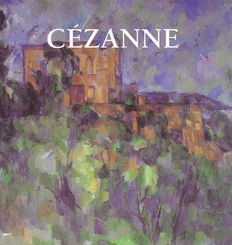
Paul Cézanne PDF
Preview Paul Cézanne
CÉZANNE MS Cezanne Layout only picture 26 Apr 04.qxd 4/28/2004 9:55 AM Page 2 © Confidential Concepts, worldwide, USA © Sirrocco, London, (English version) ISBN : 978-1-78042-468-2 All rights reserved. No part of this publication may be reproduced or adapted without the permission of the copyright holder, throughout the world. Unless otherwise specified, copyright on the works reproduced lies with the respective photographers. Despite intensive research, it has not always been possible to establish copyright ownership. Where this is the case, we would appreciate notification. MS Cezanne Layout only picture 26 Apr 04.qxd 4/28/2004 9:55 AM Page 3 Paul CØzanne Square eng(n).qxp 01/08/05 10:31 AM Page 3 Paul Cézanne MS Cezanne Layout only picture 26 Apr 04.qxd 4/28/2004 9:55 AM Page 4 4 MS Cezanne Layout only picture 26 Apr 04.qxd 4/28/2004 9:55 AM Page 5 Paul CØzanne Square eng(n).qxp 01/07/05 11:39 AM Page 5 A t the turn of the century, Cézanne began to be taken more and more seriously by the avant-garde: Matisse, Picasso, Braque, Vlaminck, Derain, and others, among them young Russian painters whose new art owed much to the master from Provence. However, many of Cézanne’s contemporaries did not realize his true greatness. When Paul Cézanne died in October 1906 in Aix-en-Provence, the Paris newspapers reacted by publishing a handful of rather equivocal obituaries. “Imperfect talent,” “crude painting,” “an artist that never was,” “incapable of anything but sketches,” owing to “a congenital sight defect” — such were the epithets showered on the great artist during his lifetime and repeated at his graveside. This was not merely due to a lack of understanding on the part of individual artists and 1. Portrait of the Artist, critics, but above all to an objective factor — the complexity of his art, his specific ca. 1873-1876. Musée d’Orsay, Paris. artistic system which he developed throughout his career and did not embody in toto in any single one of his works. Cézanne was perhaps the most complex artist of the 2. Portrait of Ivan nineteenth century. Morozov. 5 MS Cezanne Layout only picture 26 Apr 04.qxd 4/28/2004 9:55 AM Page 6 3. The Four Seasons, 1859-1860. Musée du Petit Palais, Paris. 6 MS Cezanne Layout only picture 26 Apr 04.qxd 4/28/2004 9:55 AM Page 7 7 MS Cezanne Layout only picture 26 Apr 04.qxd 4/28/2004 9:55 AM Page 8 Paul CØzanne Square eng(n).qxp 01/07/05 11:39 AM Page 8 “One cannot help feeling something akin to awe in the face of Cézanne’s greatness,” wrote Lionello Venturi. “You seem to be entering an unfamiliar world — rich and austere with peaks so high that they seem inaccessible.”1 It is not in fact an easy thing to attain those heights. Today Cézanne’s art unfolds before us with all the consistency of a logical development, the first stages of which already contain the seeds of the final fruit. But to a person who could see only separate fragments of the whole, much of Cézanne’s œuvre must naturally have seemed strange and incomprehensible. Most people were struck by the odd diversity of styles and the differing stages of completion of his paintings. In some paintings, one saw a fury of emotion, which bursts through in vigorous, tumultuous forms and in brutally powerful volumes apparently sculpted in colored clay; in others, there was rational, carefully conceived composition and an incredible variety of color modulations. Some works resembled rough sketches in which a few transparent brushstrokes produced a sense of depth, while in others, powerfully modeled figures entered into complex, interdependent spatial relationships — what the Russian artist Alexei Nürenberg has aptly called “the tying together of space.”2 Cézanne himself, with his constant laments about the impossibility of conveying his own sensations, prompted critics to speak of the fragmentary character of his work. He saw each of his paintings as nothing but an incomplete part of the whole. Often, after dozens of interminable sessions, Cézanne would abandon the picture he had started, hoping to return to it later. In each succeeding work he would try to overcome the imperfection of the previous one, to make it more finished than before: “I am long on hair and beard but short on talent.”3 Exactly a month before his death, Cézanne wrote to Émile Bernard: “Shall I attain the aim so ardently desired and so long pursued? I want to, but as long as the goal is not reached, I shall feel a vague malaise until I reach the haven, that is, until I achieve a greater perfection than before, and thus prove the tightness of my theories.” Such thoughts, shot through with bitterness, are a tragic theme recurring in Cézanne’s correspondence and conversations with his friends. They are the tragedy of his whole 4. Two Women and life — a tragedy of constant doubting, dissatisfaction, and lack of confidence in his Child in an Interior, own ability. But here, too, was the mainspring of his art, which developed as a tree early 1860s. grows or a rock forms — by the slow accumulation of more and more new layers on a The Pushkin Museum of Fine Arts, Moscow. given foundation. 8 MS Cezanne Layout only picture 26 Apr 04.qxd 4/28/2004 9:55 AM Page 9 Paul CØzanne Square eng(n).qxp 01/07/05 11:39 AM Page 9 9 MS Cezanne Layout only picture 26 Apr 04.qxd 4/28/2004 9:55 AM Page 10 Paul CØzanne Square eng(n).qxp 01/07/05 11:39 AM Page 10 5. Pastoral, ca. 1870. Musée d’Orsay, Paris. 10
